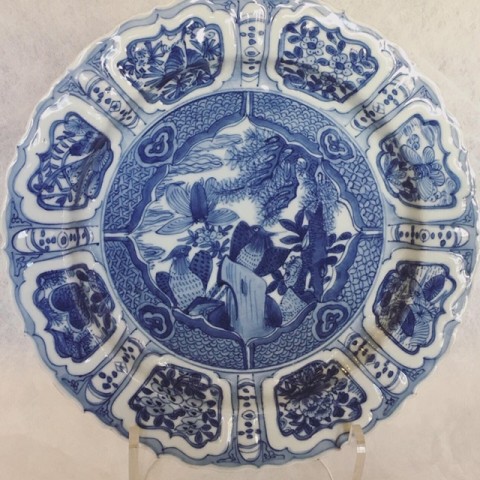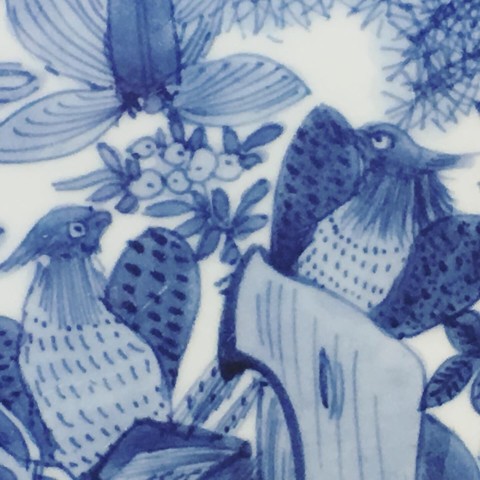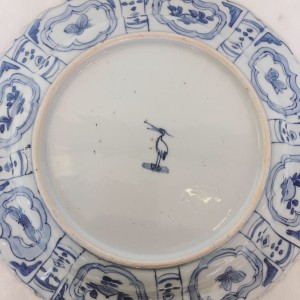BG04
Further images
Finely potted, of round form with shallow lobed sides and a moulded rim, decorated in shades of underglaze blue, the centre depicts two eagles perched on rocks beneath the boughs of a pine tree, looking up at an enormous butterfly, all contained within a flower-shaped cartouche with eight alternating panels, four of diaper pattern and four of scale-work, with four ruyi heads between them; the flattened rim is decorated with eight wide panels divided by eight thin panels; the wide panels each contain plants or insects, including peony, a butterfly, and aquatic plants; the thin panels each contain dots and lozenges; the reverse is painted with eight wide panels divided by eight thin panels, the thin panels each with a geometric design, each wide panel painted with alternating insects and stylised peaches; the base glazed, bearing an egret mark in underglaze blue in the centre.
Literature
There is a similar dish, also bearing an egret mark, in the collection of the British Museum, London (museum number 1923,0611.1). They date theirs c. 1600 - 1620, and it is referenced in Harrison-Hall Jessica, Catalogue of Late Yuan and Ming Ceramics in the British Museum, London, BMP, 2001; and in Rawson, Jessica, Chinese Ornament: The Lotus and the Dragon, London, BMP, 198, fig. 3. Here we quote from Harrison-Hall:
'Kraak'-style dishes are seldom found in Chinese domestic contexts. However, four blue-and-white 'kraak' dishes were excavated from the tomb of Wu Nianxu (1547-1614), a provincial administration commissioner, and of his wife Mme He (1547-1610). These dishes have a similar although not identical border arrangement to that of the present dish, but are of lower quality.
'The egret mark appears almost exclusively on good-quality 'kraak' wares, mostly dishes of small to medium size. It has been suggested that the mark identifies this particular type of 'kraak' ware with a specific kiln or workshop, which was manufacturing during the late sixteenth and early seventeenth centuries'
The egret mark has been recorded on only about forty-five pieces of Kraak ware. For a discussion of this type of Kraak porcelain, see M. Rinaldi, Kraak Porcelain. A Moment in the History of Trade, London, 1989, pp. 195-208. On the topic of egret marks on Kraak wares, Rinaldi writes:
'The forty-five Kraak wares with the egret mark noted [in her book] are the pieces [Rinaldi] has been able to locate. Of these wares, three are in a Middle Eastern collection (the Topkapi Saray Museum); one is in Japan (the Kobe City Museum); four are in the Unites States; the other thrity-seven are in Europe: twenty-three are in The Netherland, eight in England, three in France and two in Portugal, of one the present location is unknown. It is impossible to establish how many more there are in unknown collections.'
Our date for this dish is based on three examples in Maura Rinaldi Kraak Porcelain (1989, Bamboo Publishing). The first is pl.81 on p.95, which Rinaldi dates 1595-1610. It has the same moulding to the body and a similar panelled pattern on the reverse. The front rim has a pattern of eight wide panels divided by eight narrow ones, and, like ours, it bears an egret mark on the back. The second is pl.83 on p.96. It has similar characteristics to pl.81, the key difference being that the front has a central cartouche of a similar shape to ours, and is similarly surrounded by diaper pattern. Rinaldi has not dated this specific illustration, but gives the border type (Border VII.1) the date range of c.1595 - 1650. The third example is pl.84 on p.97, which is another example of border type VII.1. Rinaldi dates this dish, which is in the collection of the National Museum, Singapore (Inv. C.0193), to c.1595 - 1610. As our dish is of the same border type, we have dated it to c. 1610.






